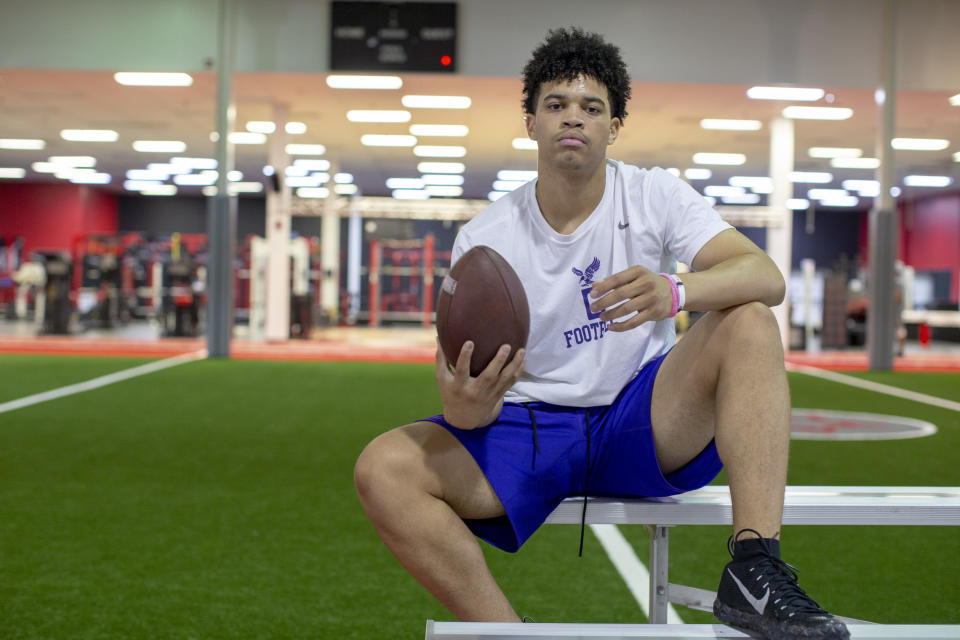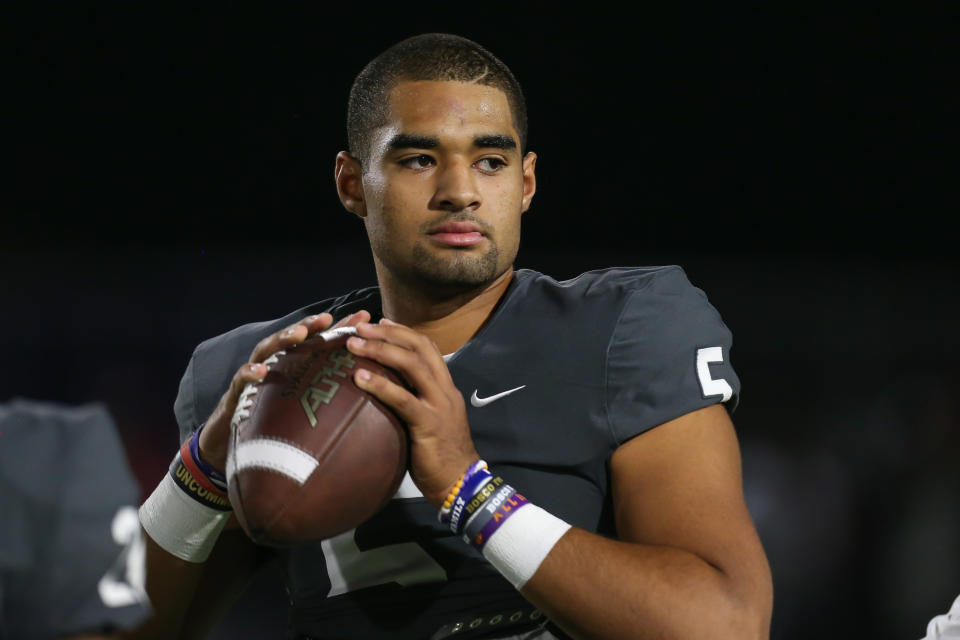Searching for the next Trevor Lawrence: A peek inside college football’s future
Caleb Williams is the top-ranked quarterback recruit in the country. He’s a 6-foot-1, 200-pound rising senior at Gonzaga High School in Washington D.C. who is debating between offers from Oklahoma, LSU and Maryland. Rivals.com ranks him the No. 3 overall player in the Class of 2021. He’s also the potential face of a new generation in college athletics.
After Williams chooses a school and begins to navigate his way through the sport, he’ll be perhaps the most high-profile test case for the NCAA’s new Name, Image and Likeness rules. They are expected to be in place by the time he’s expected to take snaps in the fall of 2021.
Williams and his father, Carl, are well aware of this. That’s part of the reason why Williams posts Instagram stories every day to his account, which has nearly 23,000 followers. (He goes by the name Caleb “Superman” Williams under the account @ayeeecaleb).
Williams will post workout videos on Twitter to his 10,500 followers, promote his Gonzaga teammates and fellow recruits on IG and give followers glimpses into his day-to-day life on Snapchat. Williams sums up his social media philosophy this way. “If you play well, get really good players at a high-profile college, things start flowing,” Williams told Yahoo Sports this week. He adds: “Your recruiting ranking doesn’t really mean anything (when you get to college). If you have followers, they’re going to come with you.”
The specifics of how NCAA’s Name, Image and Likeness legislation will look won’t be known for a few months. But what’s already emerged in football, and is of increasing importance to Williams’ generation, is the sprint to reach and cultivate an audience. The new arms race in college sports will revolve around helping players amass followers.
Call it growing a brand. Call it building a following. But how big of a reach a player like Williams has entering college is expected to translate into how much he’s worth, as social media projects as a place a high-profile player like Williams can earn some money.

Williams knows that playing well and performing in big games will ultimately determine his value and reach. And while it’s not one of the primary factors in his recruiting, the ability for a school to help maximize his Name, Image and Likeness is part of his approach. (He said all three schools he’s considering have discussed this with him at length.)
Carl Williams describes the scope of the potential business piece for his son this way.
“A ton, a ton,” Carl Williams said when asked how big of a factor. “It’s a part of our calculation. Where are the best markets to help the brand? Who has the marketing machine behind them to push him toward a Heisman? From a quarterback perspective, you have to have that on your mind. It’s not at the forefront, but there are places that haven’t been great at that one thing. That’s got to factor in at some point.”
A curious transaction passed through the college sports wire in recent weeks. Two of LSU’s top video team members – Will Stout and Jacob Brown – got hired by USC. The transaction underscored the reality of the times, as the value of those who can enhance, create and amplify a player’s image are becoming a more coveted commodity. (Stout and Brown became known for their hype videos amid LSU’s 15-0 season.)
Schools like Clemson, Ohio State, Alabama and many others have built their own media machines, filled with social media gurus, slick graphics and brand builders. Oklahoma famously provided each of the recruits who signed with the Sooners in the Class of 2020 a personalized logo.
“I envision a future where recruiting includes a presentation that you give to a kid – here are the players that you are like,” said a football administrator at a Power Five school. “Here’s what they were able to generate on their own brand. Come here and you can make $500,000. Go there and you’ll make 20-percent less.”
That means there will be a trickle-down effect, according to Zach Soskin, an athlete ambassador with Voltage Management who has spent a lot of time studying this space. Soskin predicted a world where high school sports end up looking more like college sports as we now know them.
Already, we’ve seen such a proliferation of nationally televised matchups of top teams from opposite coasts that they’ve become expected. St. John Bosco High School in Bellflower (California) played three East Coast schools last season and another in Hawaii. It’s not a coincidence they had the nation’s top quarterback, Clemson-bound D.J. Uiagalelei. More of those cross-country games showcasing high-profile players are expected.
“You’re seeing the professionalization of the high schools right now,” Soskin said. “If college guys are going to be treated like pros, we’re going to treat high school athletes like we treat college. Everyone is going to be looking for the next Trevor Lawrence or D.J. Uiagalelei.”

That’s the space Williams finds himself in right now, on the cusp of a college experience that no one has ever experienced. He’s expected to choose between Maryland, LSU and OU before the end of the summer. (He’s said he’s been to OU and LSU three or four times each and local school Maryland “countless” times.)
When Williams first heard about the NIL legislation passing, his initial thought was excitement over the popular EA Sports NCAA video game returning. He’d grown up on the game, often playing as Oregon and scoring touchdowns with former Duck De’Anthony Thomas.
While that video game returning appears unlikely, Williams soon shifted his focus to how it could benefit he and his family. He said that topic often comes up in conversation with his father and two mentors. Williams stresses over and over in conversation that the spoils of his following won’t come if he doesn’t play well, or win a starting quarterback job.
But he and his family have thought through the future enough to envision having someone on the ground in college to help him manage the business of his brand. “I don’t think I’m going to be able to do it myself,” he said.
And that philosophy includes the hallmark of Williams’ social media feed. He’s constantly promoting and congratulating his teammates on their scholarship offers and accolades. More of his posts appear to be promoting others than himself. (He also said he tries hard to respond to all the fans who reach out on social media.)
Williams does the same shouting out recruits who may join him at his next spot, cultivating relationships at all-star games and over social media. How much Caleb Williams and his generation of star athletes can make off social media is still to be determined. But as that moment comes, he and his family are embracing the opportunity and building toward it one follower at a time.
“Athletes not being able to make money for themselves off their name and image is kind of crazy,” Williams said. “They can’t work a job with school and football. I think it’s huge for them to do this for the players. They’ll be able to make money for themselves and send back home to their families if they’re struggling. This is an opportunity to make some money and better ourselves.”
More from Yahoo Sports:

 Yahoo Sports
Yahoo Sports